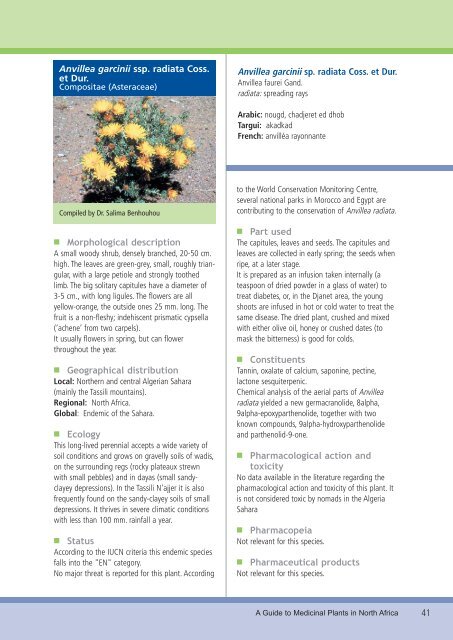pdf file - Centre for Mediterranean Cooperation IUCN-Med
pdf file - Centre for Mediterranean Cooperation IUCN-Med
pdf file - Centre for Mediterranean Cooperation IUCN-Med
You also want an ePaper? Increase the reach of your titles
YUMPU automatically turns print PDFs into web optimized ePapers that Google loves.
Anvillea garcinii ssp. radiata Coss.et Dur.Compositae (Asteraceae)Anvillea garcinii sp. radiata Coss. et Dur.Anvillea faurei Gand.radiata: spreading raysArabic: nougd, chadjeret ed dhobTargui: akadkadFrench: anvilléa rayonnanteCompiled by Dr. Salima Benhouhou■ Morphological descriptionA small woody shrub, densely branched, 20-50 cm.high. The leaves are green-grey, small, roughly triangular,with a large petiole and strongly toothedlimb. The big solitary capitules have a diameter of3-5 cm., with long ligules. The flowers are allyellow-orange, the outside ones 25 mm. long. Thefruit is a non-fleshy; indehiscent prismatic cypsella(‘achene’ from two carpels).It usually flowers in spring, but can flowerthroughout the year.■ Geographical distributionLocal: Northern and central Algerian Sahara(mainly the Tassili mountains).Regional: North Africa.Global: Endemic of the Sahara.■ EcologyThis long-lived perennial accepts a wide variety ofsoil conditions and grows on gravelly soils of wadis,on the surrounding regs (rocky plateaux strewnwith small pebbles) and in dayas (small sandyclayeydepressions). In the Tassili N'ajjer it is alsofrequently found on the sandy-clayey soils of smalldepressions. It thrives in severe climatic conditionswith less than 100 mm. rainfall a year.■ StatusAccording to the <strong>IUCN</strong> criteria this endemic speciesfalls into the "EN" category.No major threat is reported <strong>for</strong> this plant. Accordingto the World Conservation Monitoring <strong>Centre</strong>,several national parks in Morocco and Egypt arecontributing to the conservation of Anvillea radiata.■ Part usedThe capitules, leaves and seeds. The capitules andleaves are collected in early spring; the seeds whenripe, at a later stage.It is prepared as an infusion taken internally (ateaspoon of dried powder in a glass of water) totreat diabetes, or, in the Djanet area, the youngshoots are infused in hot or cold water to treat thesame disease. The dried plant, crushed and mixedwith either olive oil, honey or crushed dates (tomask the bitterness) is good <strong>for</strong> colds.■ ConstituentsTannin, oxalate of calcium, saponine, pectine,lactone sesquiterpenic.Chemical analysis of the aerial parts of Anvillearadiata yielded a new germacranolide, 8alpha,9alpha-epoxyparthenolide, together with twoknown compounds, 9alpha-hydroxyparthenolideand parthenolid-9-one.■ Pharmacological action andtoxicityNo data available in the literature regarding thepharmacological action and toxicity of this plant. Itis not considered toxic by nomads in the AlgeriaSahara■ PharmacopeiaNot relevant <strong>for</strong> this species.■ Pharmaceutical productsNot relevant <strong>for</strong> this species.A Guide to <strong>Med</strong>icinal Plants in North Africa 41
■ Traditional medicine and localknowledgeTaken <strong>for</strong> colds, diabetes, digestive problems,gastro-intestinal troubles, indigestion, pulmonaryaffections.Considered as good pasture, particularly when inflower, it enhances zootechnic per<strong>for</strong>mance, favoursgrowth and is regarded by shepherds as tonic andstimulating.In Morocco, it is taken as an infusion to calm diarrhoeaand gastro-intestinal troubles. It is used totreat liver diseases and is taken as a decoction withZygophyllum gaetulumn, Brocchia cinerea andWarionia saharae.The crushed seeds mixed with honey or olive oil areexcellent <strong>for</strong> colds. An infusion of the leaves emulsifiedin olive oil is used to <strong>for</strong> rectal injection to treatcolds.Certain herbalists prepare suppositories containingthe powdered seeds mixed with nigella, cress andMaerua crassifolia. They are good <strong>for</strong> colds butunsuitable <strong>for</strong> children and pregnant women.■ReferencesRelevant to the plant and its usesEl Hassany, B., El Hanbali, F., Akssira, M., Mellouki,F., Haidour, A., Barrero, AF., 2004.Germacranolides from Anvillea radiata. Fitoterapia.75(6). pp. 573-576.General referencesBellakhdar, J., 1997. La pharmacopée marocainetraditionnelle. Médecine arabe ancienne etsavoirs populaires. IBIS Press. 764 p.Benchelah, A.C., Bouziane, H., Maka, M. & Ouahes,C., 2000. Fleurs du Sahara.Voyage et ethnobotanique avec les touaregs duTassili. Ed.Ibis Press, Paris. 255 p.Benhouhou, S.S. & Saadoun, N., 1986. Contributionà l'étude de la flore de larégion de Béni-Abbès. Undergraduate thesis.University of Algiers. 241 p.Ozenda, P., 1991. Flore et végétation du Sahara. Ed.CNRS, Paris. 662 p.Quézel, P. & Santa, S. 1962-1963. Nouvelle Flore del'Algérie et des régions désertiques méridionales.CNRS, Paris, 2 vol.1170 p.Sitouh, M., 1989. Les plantes utiles du Sahara. Ann.Inst. Nat. Agro. El Harrach, Alger, vol. 13, n°2.pp. 583-658.Tataï, J., 1993. Contribution à l'étude de la floremédicinale de la région de Messad (W.Djelfa). Undergraduate theses. National Institute ofAgriculture. 128 p.Trabut, L., 1935. Répertoires des noms indigènesdes plantes spontanées, cultivées et utiliséesdans le Nord de l'Afrique. Collection du Centenairede l'Algérie, Alger. 355 p.42A Guide to <strong>Med</strong>icinal Plants in North Africa
















